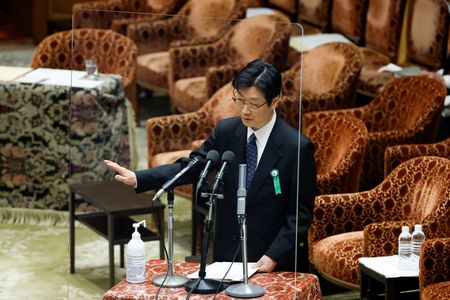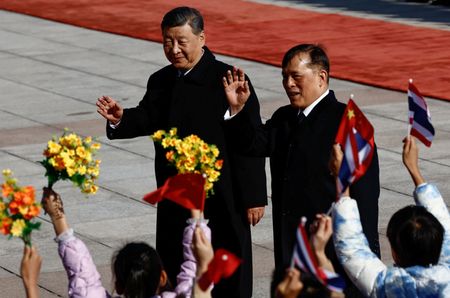By Eduardo Baptista and Joey Roulette
BEIJING (Reuters) -Three Chinese astronauts whose return to Earth was delayed by space debris hitting their vessel last week have boarded another spacecraft and are expected to land in China on Friday, the China Manned Space Agency (CMSA) said.
The Chinese space agency also revealed details about the debris damage for the first time, saying “tiny cracks” were found in a small window of the Shenzhou-20 spacecraft’s return capsule.
“The capsule does not meet the safety requirements for a crewed return, Shenzhou-20 will remain in orbit and conduct relevant experiments,” the agency said in a statement.
The astronauts were due to return to Earth nine days ago after completing a six-month mission on China’s permanently inhabited Tiangong space station, a programme known as Shenzhou, or “Divine Vessel”, when the crack was discovered.
The crew had left Tiangong and started the journey home on another spacecraft, the Shenzhou-21, according to CMSA, with a return to the Dongfeng landing site in northern China’s Inner Mongolia Autonomous Region scheduled for Friday afternoon.
The mission began in April and went smoothly until, the CMSA said, a “suspected impact from tiny space debris” forced a postponement of the Shenzhou-20’s return, originally scheduled for November 5.
The delay, while only nine days, is highly unusual for a programme that has run like clockwork and in the past year reached new milestones, with the deployment of astronauts born in the 1990s, a world-record spacewalk and plans to send the first foreign astronaut, from Pakistan, to Tiangong next year.
Every Shenzhou mission aboard Tiangong ends with a handover, where the departing crew welcomes the arriving crew that will take over the space station’s operations. During the handover period of several days, two Shenzhou vessels are docked at the space station.
China’s manned space programme now has to deal with another logistical headache – how to get the space station’s newly arrived crew home in the event of an emergency.
CMSA said the Shenzhou-22 spacecraft would be launched at “an appropriate time in the future”.
SPACE JUNK DANGER
The damage to the Chinese spacecraft highlights the challenges posed by growing quantities of “space junk” to space exploration.
“Due to the sharp increase in orbital debris, the likelihood of damage to spacecraft and space stations of all countries has risen significantly,” Igor Marinin, a member of the Russian Academy of Cosmonautics in Moscow, told Reuters.
While this is the first known debris disruption for a Shenzhou mission, junk in space has ensnared past missions to the International Space Station, the 25-year-old science lab led by the United States and Russia.
The SpaceX capsule NASA uses to transport astronauts to the ISS has had to dodge suspected pieces of space debris during flight, while the football field-sized station itself has manoeuvred several times to steer clear of junk.
Breakups of old, defunct satellites, mishaps with active ones and anti-satellite weapon tests can create vast swarms of space debris that remain in orbit for years.
The sudden breakup of an old Russian satellite last year created at least 180 pieces of trackable debris, forcing ISS astronauts to prepare for evacuation. A spent Chinese rocket stage later that year created nearly 1,000 pieces of junk after possibly colliding with debris.
The threat has prompted calls for rival space powers U.S. and China to collaborate on space debris mitigation and satellite traffic rules, though U.S. law largely bars NASA from working with Beijing’s space programme.
Still, the U.S. and China have increasingly coordinated on space safety matters in recent years, largely on an ad-hoc basis. Chinese spacecraft manoeuvre alerts to U.S. operators stepped up last year to the Pentagon and with NASA, Reuters reported.
U.S. space agency NASA last year saw two of their astronauts getting stranded for nine months in the ISS due to propulsion system issues in their vessel, a Boeing Starliner spacecraft.
(Reporting by Eduardo Baptista, Joey Roulette, and Maxim Shemetov; Editing by Jamie Freed and Stephen Coates)












